
LLMTSCS
Official code for article "LLMLight: Large Language Models as Traffic Signal Control Agents".
Stars: 173
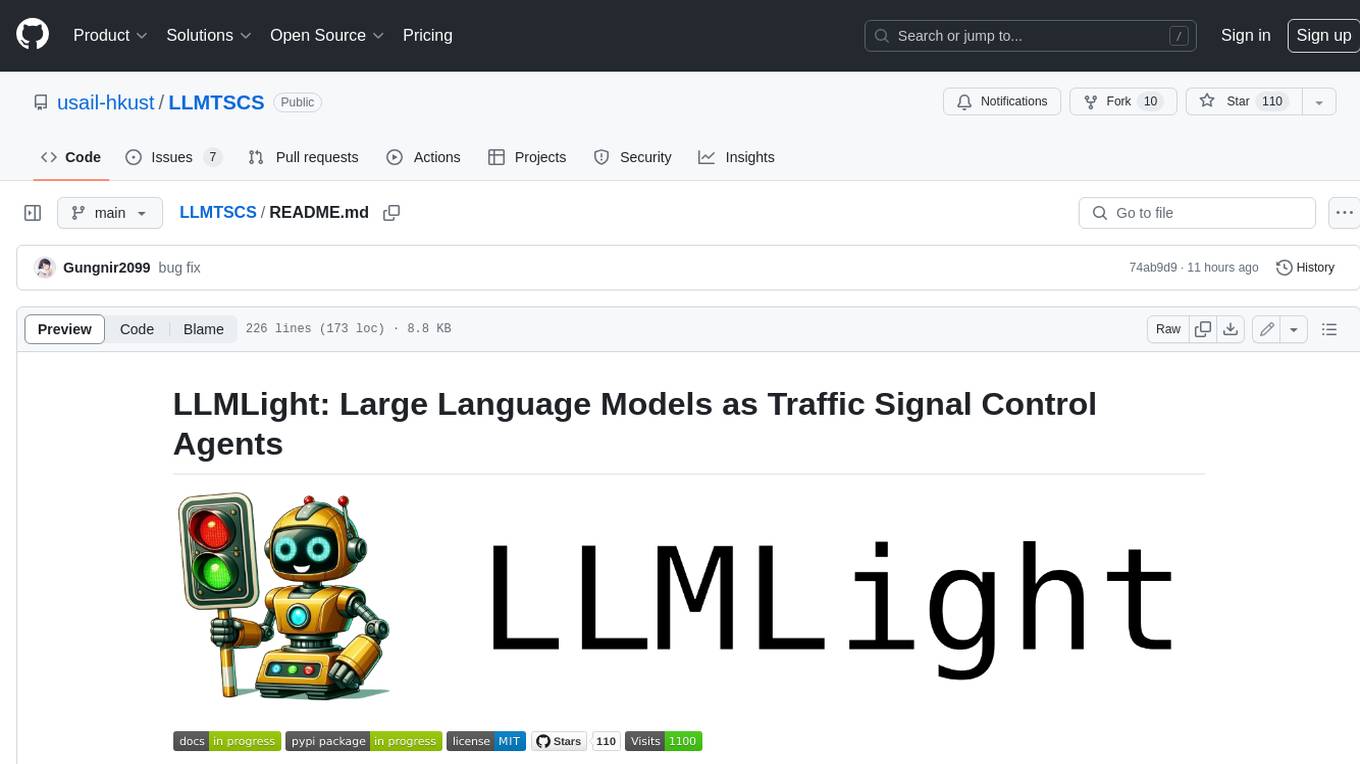
LLMLight is a novel framework that employs Large Language Models (LLMs) as decision-making agents for Traffic Signal Control (TSC). The framework leverages the advanced generalization capabilities of LLMs to engage in a reasoning and decision-making process akin to human intuition for effective traffic control. LLMLight has been demonstrated to be remarkably effective, generalizable, and interpretable against various transportation-based and RL-based baselines on nine real-world and synthetic datasets.
README:
| 1 Introduction | 2 Requirements | 3 Usage | 4 Baselines | 5 LightGPT Training | 6 Code structure | 7 Datasets | 8 Citation | Website |
- [x] 🚀🔥 [2024.11] 🎯🎯📢📢 Exciting News! We are thrilled to announce that our 🌟LLMLight🌟 has been accepted by KDD'2025! 🎉🎉🎉 Thanks to all the team members 🤗
- [x] 🚀🔥 [2024.11] 🎯🎯📢📢 Exciting Update! We’re thrilled to announce that our LightGPT family has expanded with four new members now available on HuggingFace. These models include fine-tuned backbones based on Qwen2 and Llama3. Check them out!
Official code for article "LLMLight: Large Language Models as Traffic Signal Control Agents".
Traffic Signal Control (TSC) is a crucial component in urban traffic management, aiming to optimize road network efficiency and reduce congestion. Traditional methods in TSC, primarily based on transportation engineering and reinforcement learning (RL), often exhibit limitations in generalization across varied traffic scenarios and lack interpretability. This paper presents LLMLight, a novel framework employing Large Language Models (LLMs) as decision-making agents for TSC. Specifically, the framework begins by instructing the LLM with a knowledgeable prompt detailing real-time traffic conditions. Leveraging the advanced generalization capabilities of LLMs, LLMLight engages a reasoning and decision-making process akin to human intuition for effective traffic control. Moreover, we build LightGPT, a specialized backbone LLM tailored for TSC tasks. By learning nuanced traffic patterns and control strategies, LightGPT enhances the LLMLight framework cost-effectively. Extensive experiments on nine real-world and synthetic datasets showcase the remarkable effectiveness, generalization ability, and interpretability of LLMLight against nine transportation-based and RL-based baselines.
The code structure is based on Efficient_XLight.
https://github.com/usail-hkust/LLMTSCS/assets/62106026/90567f61-5d58-4dac-8c8e-836a421f3ff9
python>=3.9,tensorflow-cpu==2.8.0, cityflow, pandas==1.5.0, numpy==1.26.2, wandb, transformers==4.45.0, peft==0.7.1, accelerate==0.27.2, datasets==2.16.1, fire, vllm==0.6.2
cityflow needs a Linux environment, and we run the code on Ubuntu.
Parameters are well-prepared, and you can run the code directly.
- For example, to run
Advanced-MPLight:
python run_advanced_mplight.py --dataset hangzhou \
--traffic_file anon_4_4_hangzhou_real.json \
--proj_name TSCS- To run GPT-3.5/GPT-4 with LLMLight, you need to set your key in
./models/chatgpt.py:
headers = {
"Content-Type": "application/json",
"Authorization": "YOUR_KEY_HERE"
}Then, run LLMLight by:
python run_chatgpt.py --prompt Commonsense \
--dataset hangzhou \
--traffic_file anon_4_4_hangzhou_real.json \
--gpt_version gpt-4 \
--proj_name TSCSYou can either choose Commonsense or Wait Time Forecast as the prompt argument.
- To run with open-sourced LLMs (or LightGPT) and LLMLight:
# with default methods of Transformers
python run_open_LLM.py --llm_model LLM_MODEL_NAME_ONLY_FOR_LOG \
--llm_path LLM_PATH \
--dataset hangzhou \
--traffic_file anon_4_4_hangzhou_real.json \
--proj_name TSCS
# or with VLLM (much faster but will cost more GPU memory)
python run_open_LLM_with_vllm.py --llm_model LLM_MODEL_NAME_ONLY_FOR_LOG \
--llm_path LLM_PATH \
--dataset hangzhou \
--traffic_file anon_4_4_hangzhou_real.json \
--proj_name TSCS-
Heuristic Methods:
- FixedTime, Maxpressure, EfficientMaxPressure
-
DNN-RL:
- PressLight, MPLight, CoLight, AttendLight, EfficientMPLight, EfficientPressLight, Efficient-Colight
-
Adv-DNN-RL:
- Advanced-MaxPressure, Advanced-MPLight, Advanced-Colight
-
LLMLight+LLM:
-
gpt-3.5-turbo-0613,gpt-4-0613,llama-2-13b-chat-hf,llama-2-70b-chat-hf
-
-
LLMLight+LightGPT:
- The model trained on Jinan 1 is available at https://huggingface.co/collections/usail-hkust/llmlight-lightgpt-673ac5a619cbbe309165b56d
python ./finetune/run_imitation_finetune.py --base_model MODEL_PATH \
--data_path DATA_PATH \
--output_dir OUTPUT_DIR
python ./finetune/merge_lora.py --adapter_model_name="OUTPUT_DIR" \
--base_model_name="MODEL_PATH" \
--output_name="MERGED_MODEL_PATH"We merge the adapter with the base model by running merge_lora.py.
- You first need to train
Advanced-CoLightby running:
python run_advanced_colight.py --dataset hangzhou \
--traffic_file anon_4_4_hangzhou_real.json \
--proj_name TSCSThe RL model weights will be automatically saved in a checkpoint folder in ./model. You need to copy it and put it under the ./model_weights/AdvancedColight/{traffic_file}/" folder.
- Then, collect the data by running:
python ./finetune/run_policy_refinement_data_collection.py --llm_model MODEL_NAME_ONLY_FOR_LOG \
--llm_path MODEL_PATH \
--dataset hangzhou \
--traffic_file anon_4_4_hangzhou_real.jsonThe fine-tuning data will be ready at ./data/cgpr/cgpr_{traffic_file}.json.
python ./finetune/run_policy_refinement.py --llm_model MODEL_NAME_ONLY_FOR_LOG \
--llm_path MODEL_PATH \
--llm_output_dir OUTPUT_DIR \
--dataset hangzhou \
--traffic_file anon_4_4_hangzhou_real.json \
--proj_name LightGPTFineTuning
python ./finetune/merge_lora.py --adapter_model_name="OUTPUT_DIR_{traffic_file}" \
--base_model_name="MODEL_PATH" \
--output_name="MERGED_MODEL_PATH"Similarly, we merge the adapter with the base model by running merge_lora.py.
-
models: contains all the models used in our article. -
utils: contains all the methods to simulate and train the models. -
frontend: contains visual replay files of different agents. -
errors: contains error logs of ChatGPT agents. -
{LLM_MODEL}_logs: contains dialog log files of a LLM. -
prompts: contains base prompts of ChatGPT agents. -
finetune: contains codes for LightGPT training.
| Road networks | Intersections | Road network arg | Traffic files |
| Jinan | 3 X 4 | jinan | anon_3_4_jinan_real |
|---|---|---|---|
| anon_3_4_jinan_real_2000 | |||
| anon_3_4_jinan_real_2500 | |||
| anon_3_4_jinan_synthetic_24000_60min | |||
| Hangzhou | 4 X 4 | hangzhou | anon_4_4_hangzhou_real |
| anon_4_4_hangzhou_real_5816 | |||
| anon_4_4_hangzhou_synthetic_24000_60min | |||
| New York | 28 X 7 | newyork_28x7 | anon_28_7_newyork_real_double |
| anon_28_7_newyork_real_triple |
@misc{lai2024llmlight,
title={LLMLight: Large Language Models as Traffic Signal Control Agents},
author={Siqi Lai and Zhao Xu and Weijia Zhang and Hao Liu and Hui Xiong},
year={2024},
eprint={2312.16044},
archivePrefix={arXiv},
primaryClass={cs.AI}
}
For Tasks:
Click tags to check more tools for each tasksFor Jobs:
Alternative AI tools for LLMTSCS
Similar Open Source Tools

LLMTSCS
LLMLight is a novel framework that employs Large Language Models (LLMs) as decision-making agents for Traffic Signal Control (TSC). The framework leverages the advanced generalization capabilities of LLMs to engage in a reasoning and decision-making process akin to human intuition for effective traffic control. LLMLight has been demonstrated to be remarkably effective, generalizable, and interpretable against various transportation-based and RL-based baselines on nine real-world and synthetic datasets.
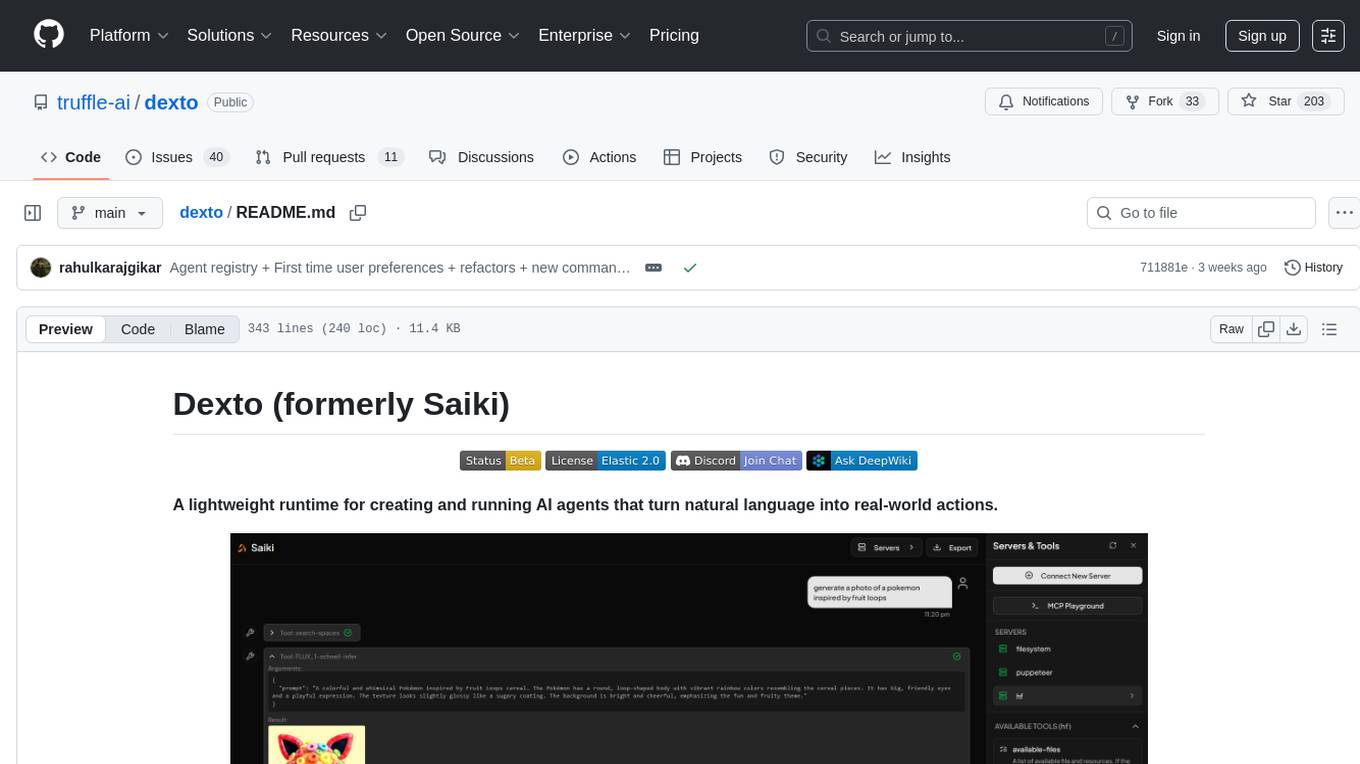
dexto
Dexto is a lightweight runtime for creating and running AI agents that turn natural language into real-world actions. It serves as the missing intelligence layer for building AI applications, standalone chatbots, or as the reasoning engine inside larger products. Dexto features a powerful CLI and Web UI for running AI agents, supports multiple interfaces, allows hot-swapping of LLMs from various providers, connects to remote tool servers via the Model Context Protocol, is config-driven with version-controlled YAML, offers production-ready core features, extensibility for custom services, and enables multi-agent collaboration via MCP and A2A.
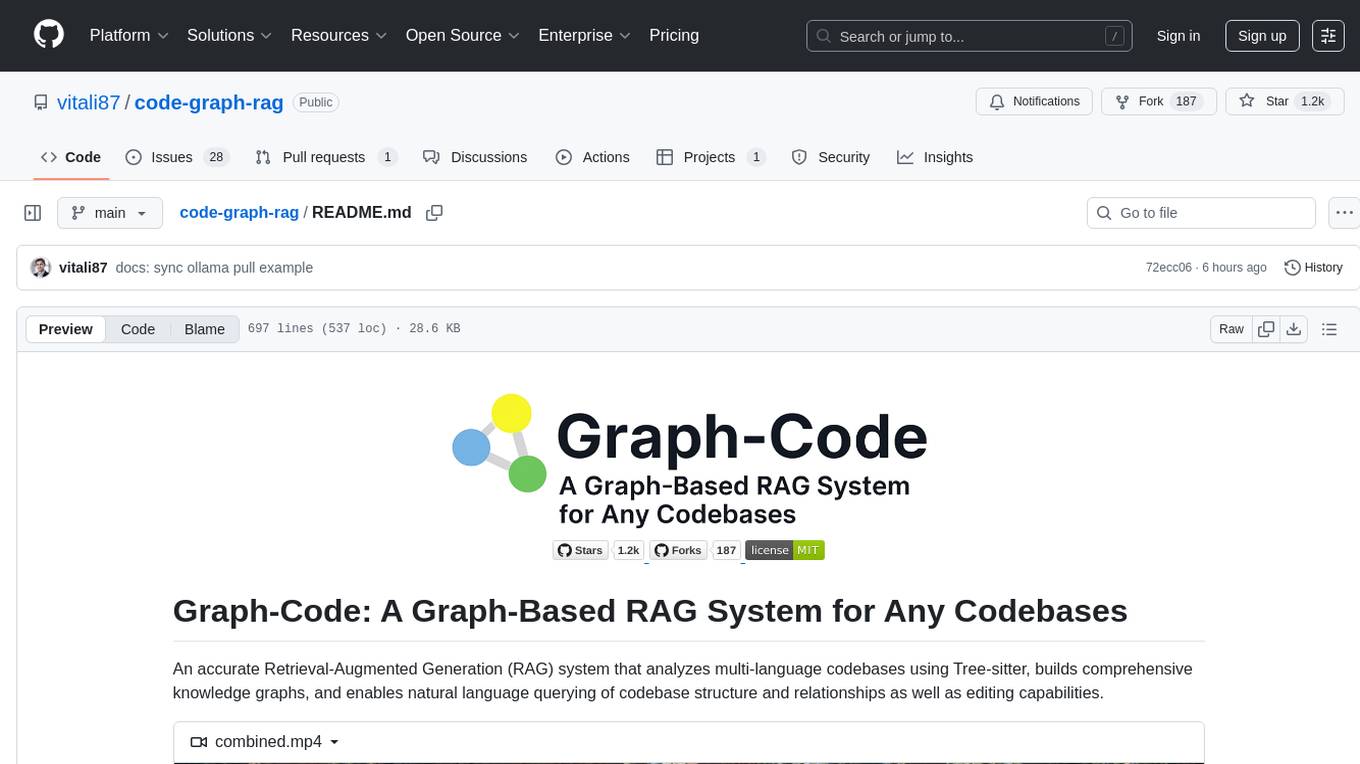
code-graph-rag
Graph-Code is an accurate Retrieval-Augmented Generation (RAG) system that analyzes multi-language codebases using Tree-sitter. It builds comprehensive knowledge graphs, enabling natural language querying of codebase structure and relationships, along with editing capabilities. The system supports various languages, uses Tree-sitter for parsing, Memgraph for storage, and AI models for natural language to Cypher translation. It offers features like code snippet retrieval, advanced file editing, shell command execution, interactive code optimization, reference-guided optimization, dependency analysis, and more. The architecture consists of a multi-language parser and an interactive CLI for querying the knowledge graph.
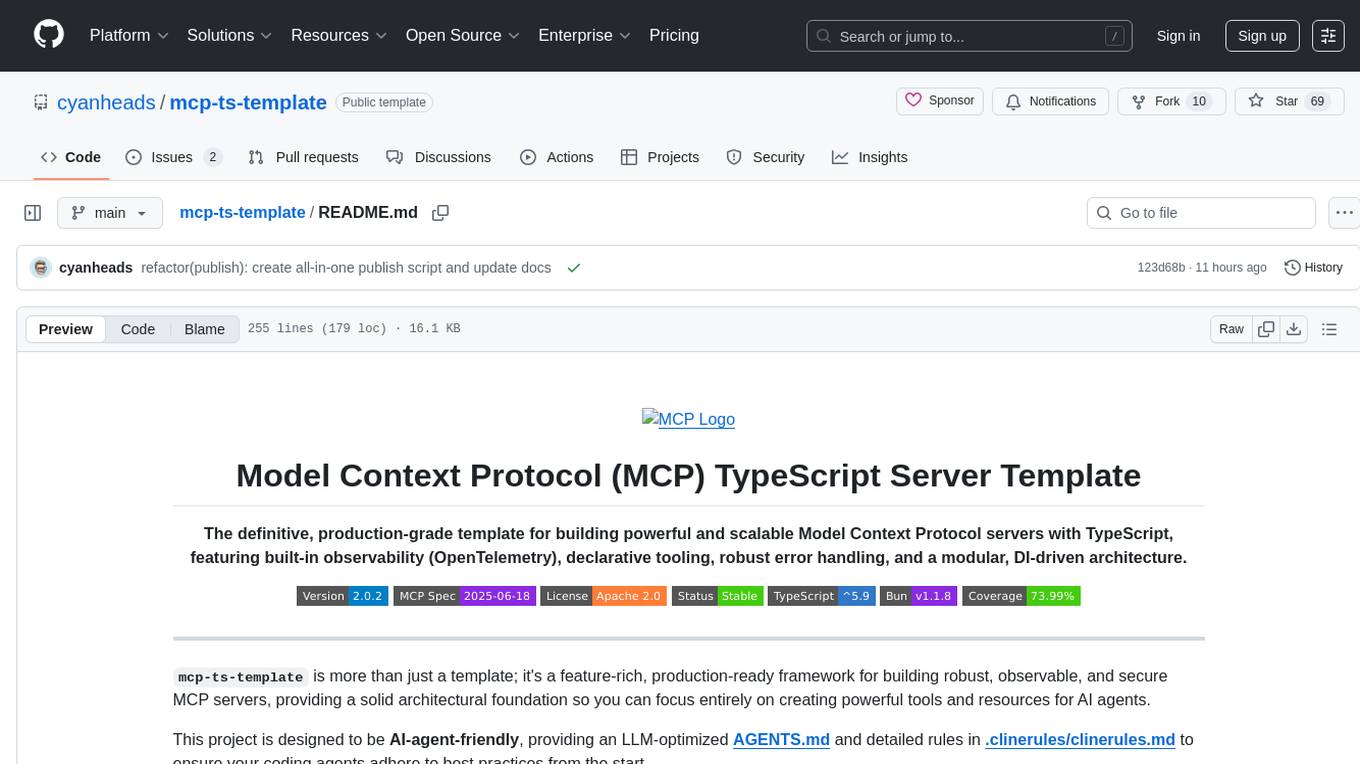
mcp-ts-template
The MCP TypeScript Server Template is a production-grade framework for building powerful and scalable Model Context Protocol servers with TypeScript. It features built-in observability, declarative tooling, robust error handling, and a modular, DI-driven architecture. The template is designed to be AI-agent-friendly, providing detailed rules and guidance for developers to adhere to best practices. It enforces architectural principles like 'Logic Throws, Handler Catches' pattern, full-stack observability, declarative components, and dependency injection for decoupling. The project structure includes directories for configuration, container setup, server resources, services, storage, utilities, tests, and more. Configuration is done via environment variables, and key scripts are available for development, testing, and publishing to the MCP Registry.
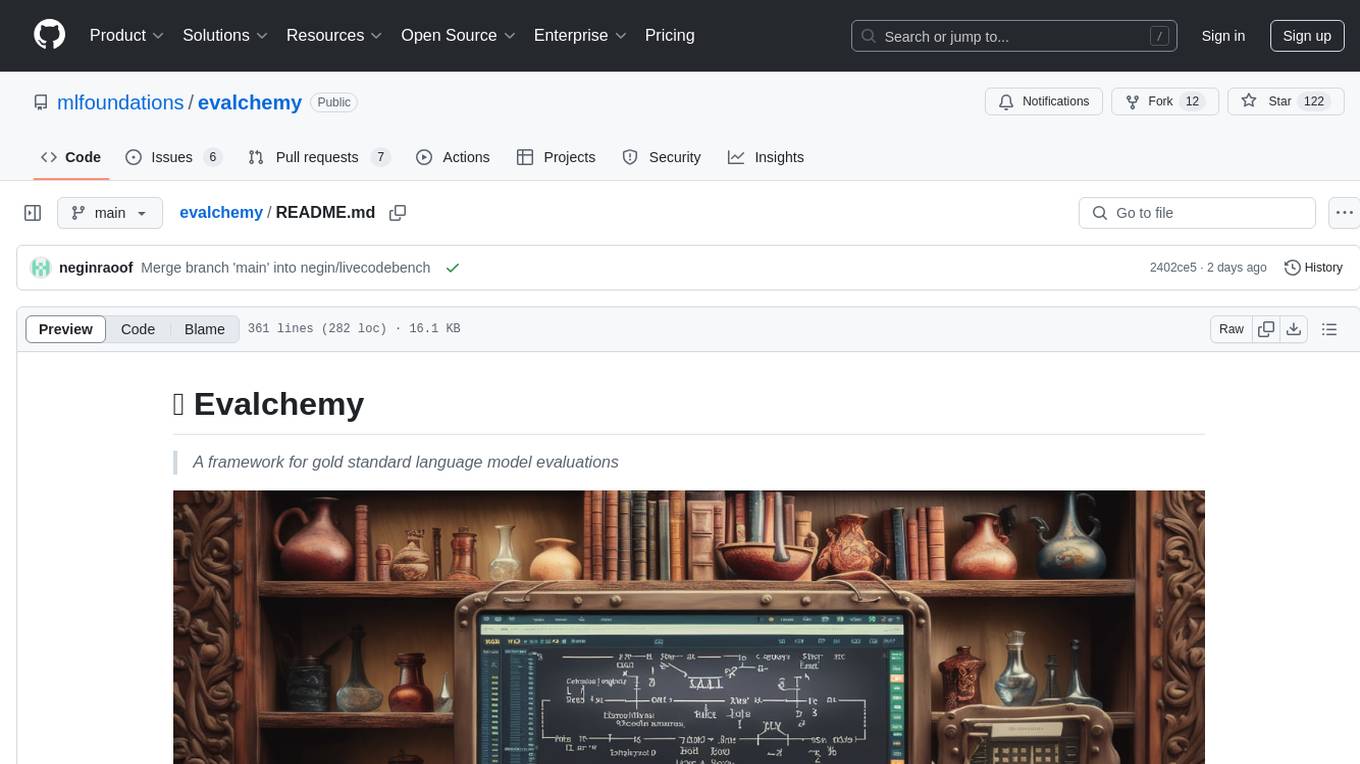
evalchemy
Evalchemy is a unified and easy-to-use toolkit for evaluating language models, focusing on post-trained models. It integrates multiple existing benchmarks such as RepoBench, AlpacaEval, and ZeroEval. Key features include unified installation, parallel evaluation, simplified usage, and results management. Users can run various benchmarks with a consistent command-line interface and track results locally or integrate with a database for systematic tracking and leaderboard submission.
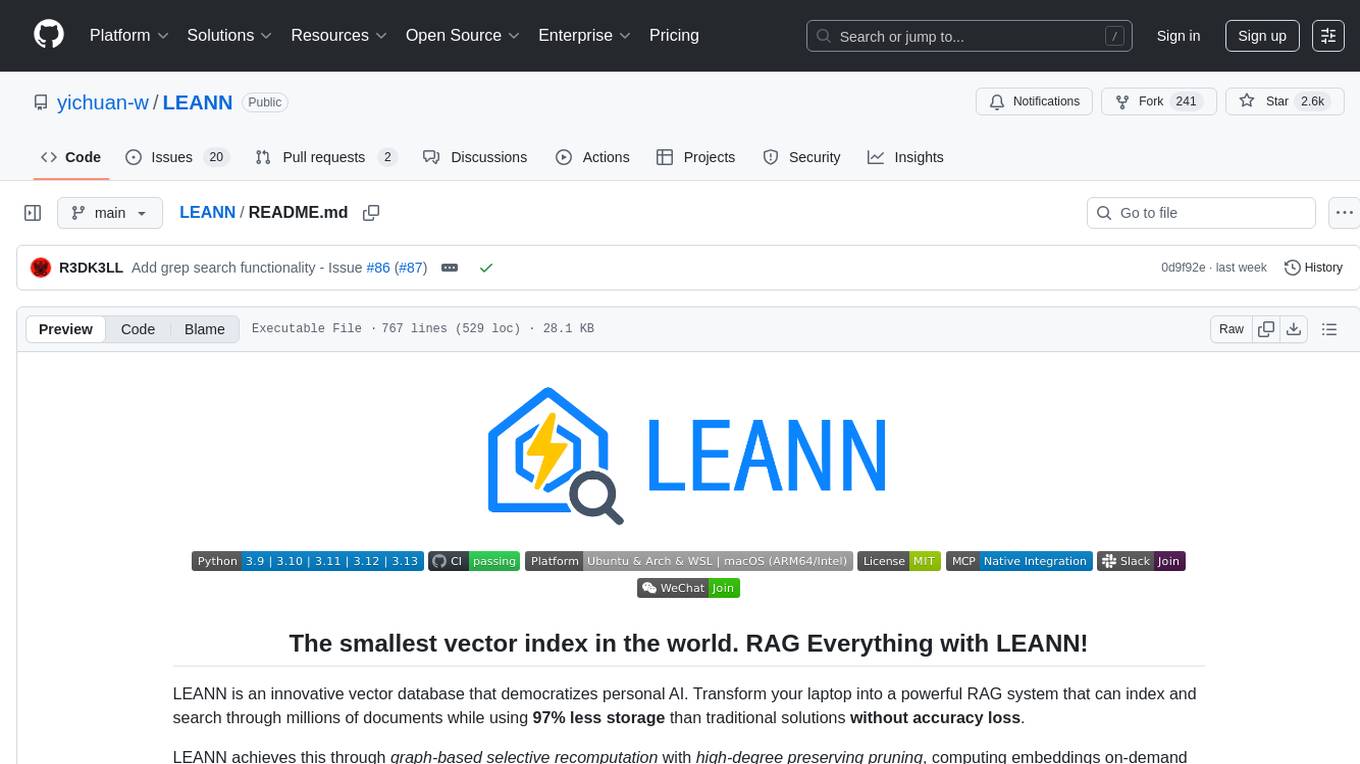
LEANN
LEANN is an innovative vector database that democratizes personal AI, transforming your laptop into a powerful RAG system that can index and search through millions of documents using 97% less storage than traditional solutions without accuracy loss. It achieves this through graph-based selective recomputation and high-degree preserving pruning, computing embeddings on-demand instead of storing them all. LEANN allows semantic search of file system, emails, browser history, chat history, codebase, or external knowledge bases on your laptop with zero cloud costs and complete privacy. It is a drop-in semantic search MCP service fully compatible with Claude Code, enabling intelligent retrieval without changing your workflow.
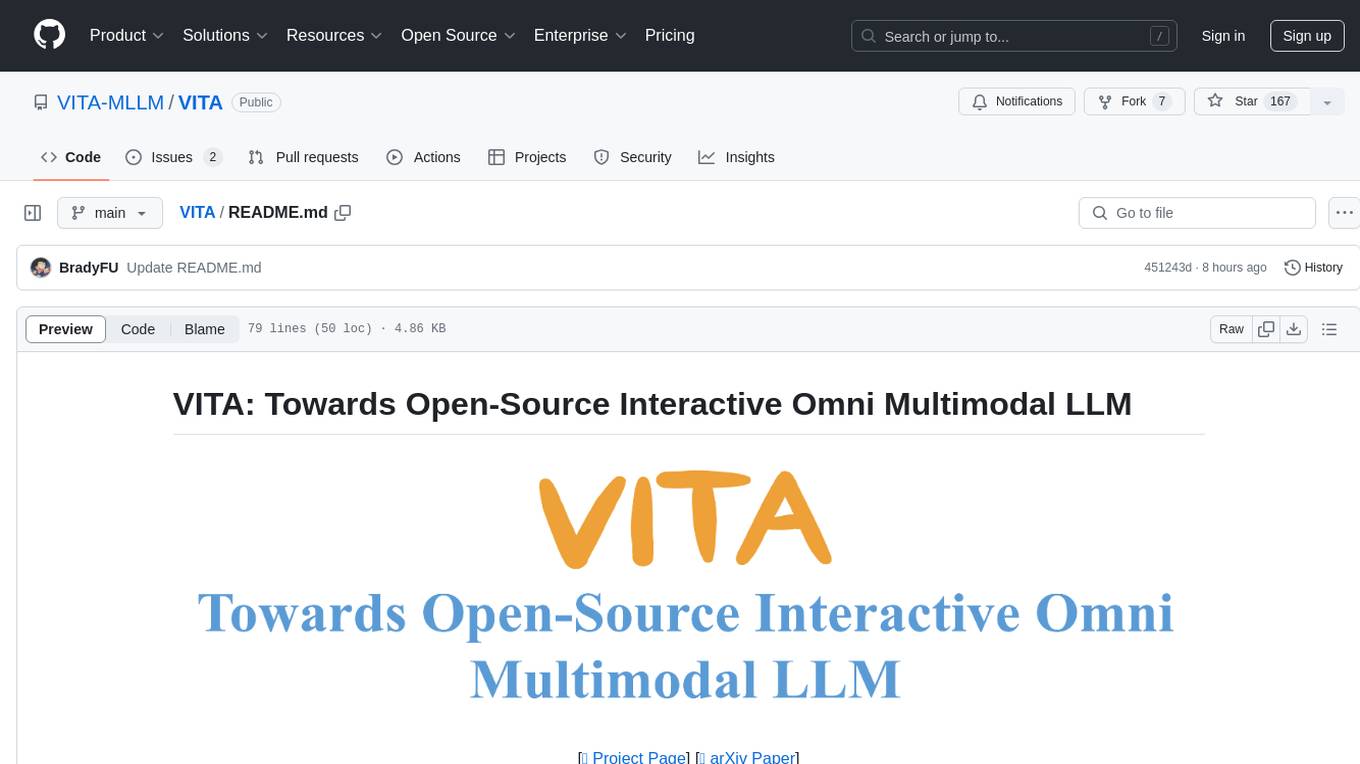
VITA
VITA is an open-source interactive omni multimodal Large Language Model (LLM) capable of processing video, image, text, and audio inputs simultaneously. It stands out with features like Omni Multimodal Understanding, Non-awakening Interaction, and Audio Interrupt Interaction. VITA can respond to user queries without a wake-up word, track and filter external queries in real-time, and handle various query inputs effectively. The model utilizes state tokens and a duplex scheme to enhance the multimodal interactive experience.
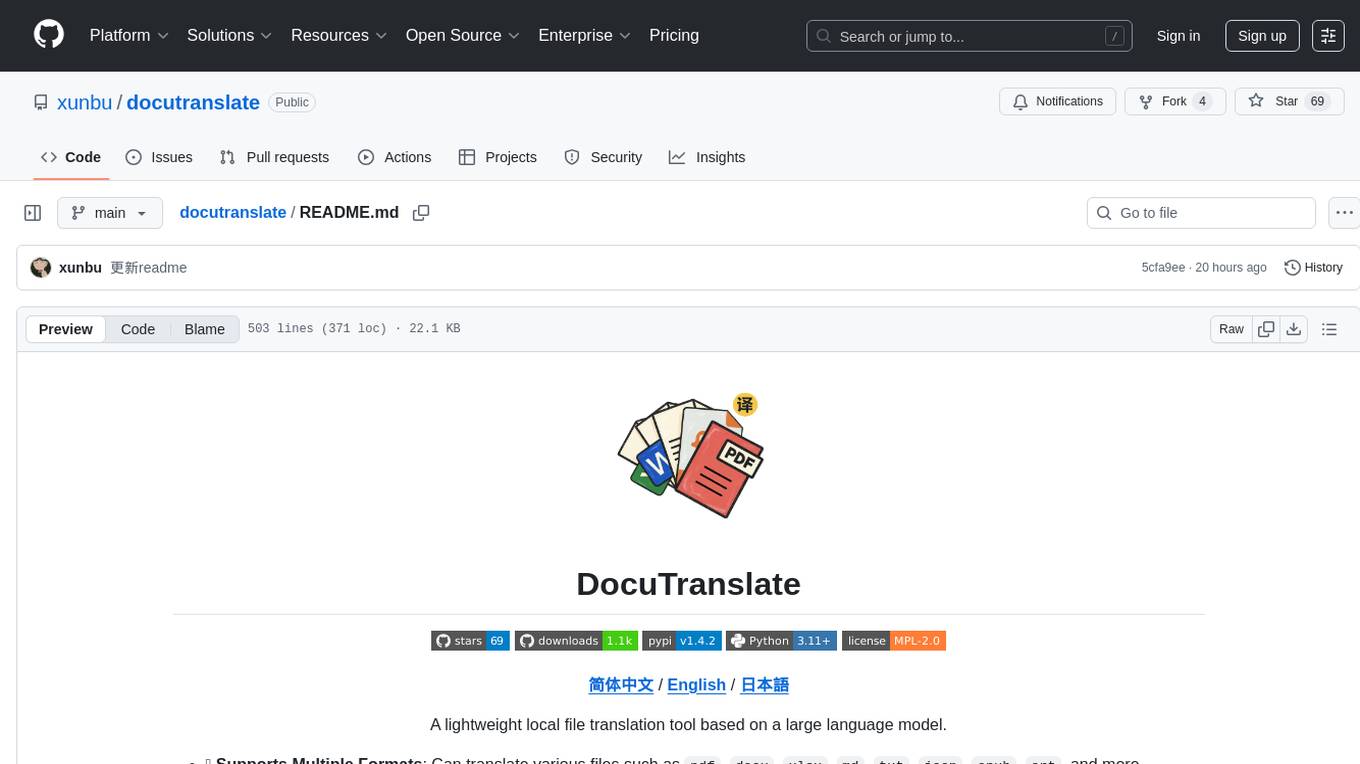
docutranslate
Docutranslate is a versatile tool for translating documents efficiently. It supports multiple file formats and languages, making it ideal for businesses and individuals needing quick and accurate translations. The tool uses advanced algorithms to ensure high-quality translations while maintaining the original document's formatting. With its user-friendly interface, Docutranslate simplifies the translation process and saves time for users. Whether you need to translate legal documents, technical manuals, or personal letters, Docutranslate is the go-to solution for all your document translation needs.
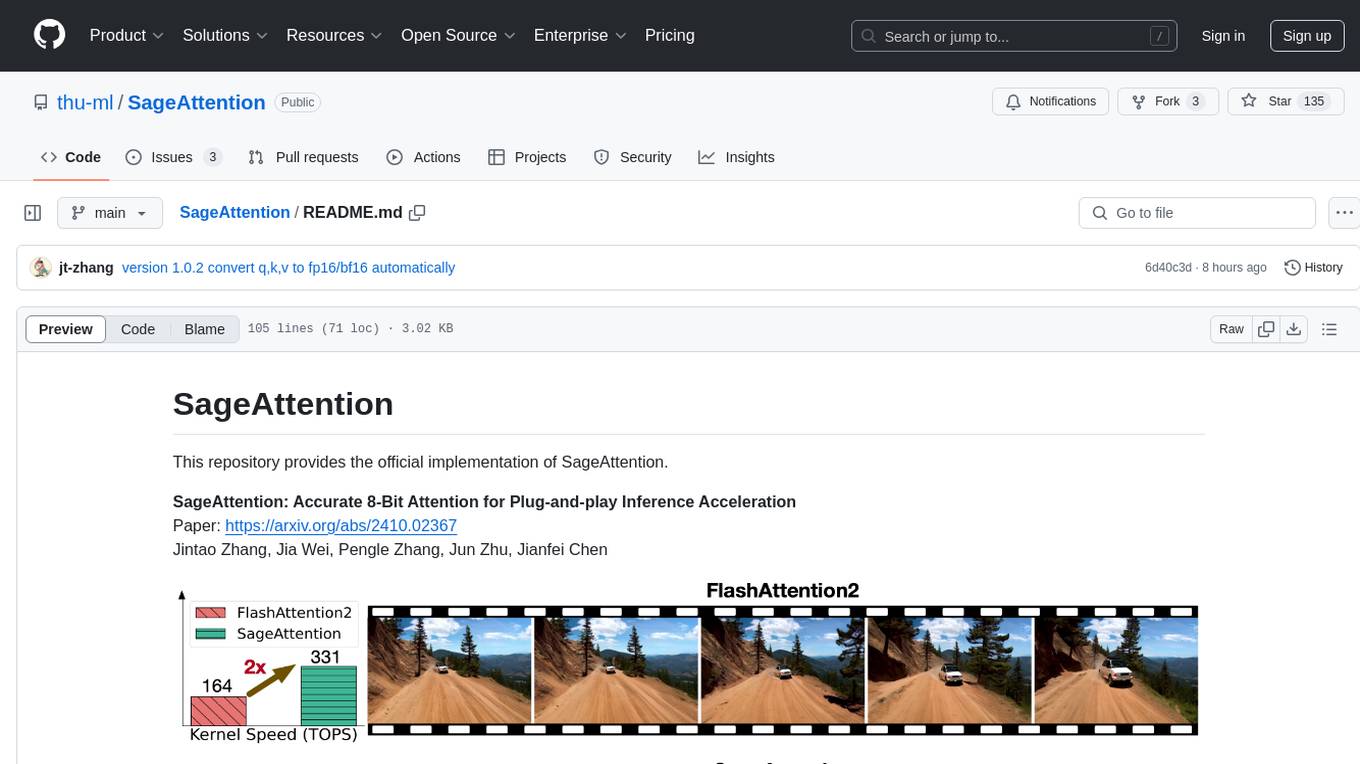
SageAttention
SageAttention is an official implementation of an accurate 8-bit attention mechanism for plug-and-play inference acceleration. It is optimized for RTX4090 and RTX3090 GPUs, providing performance improvements for specific GPU architectures. The tool offers a technique called 'smooth_k' to ensure accuracy in processing FP16/BF16 data. Users can easily replace 'scaled_dot_product_attention' with SageAttention for faster video processing.
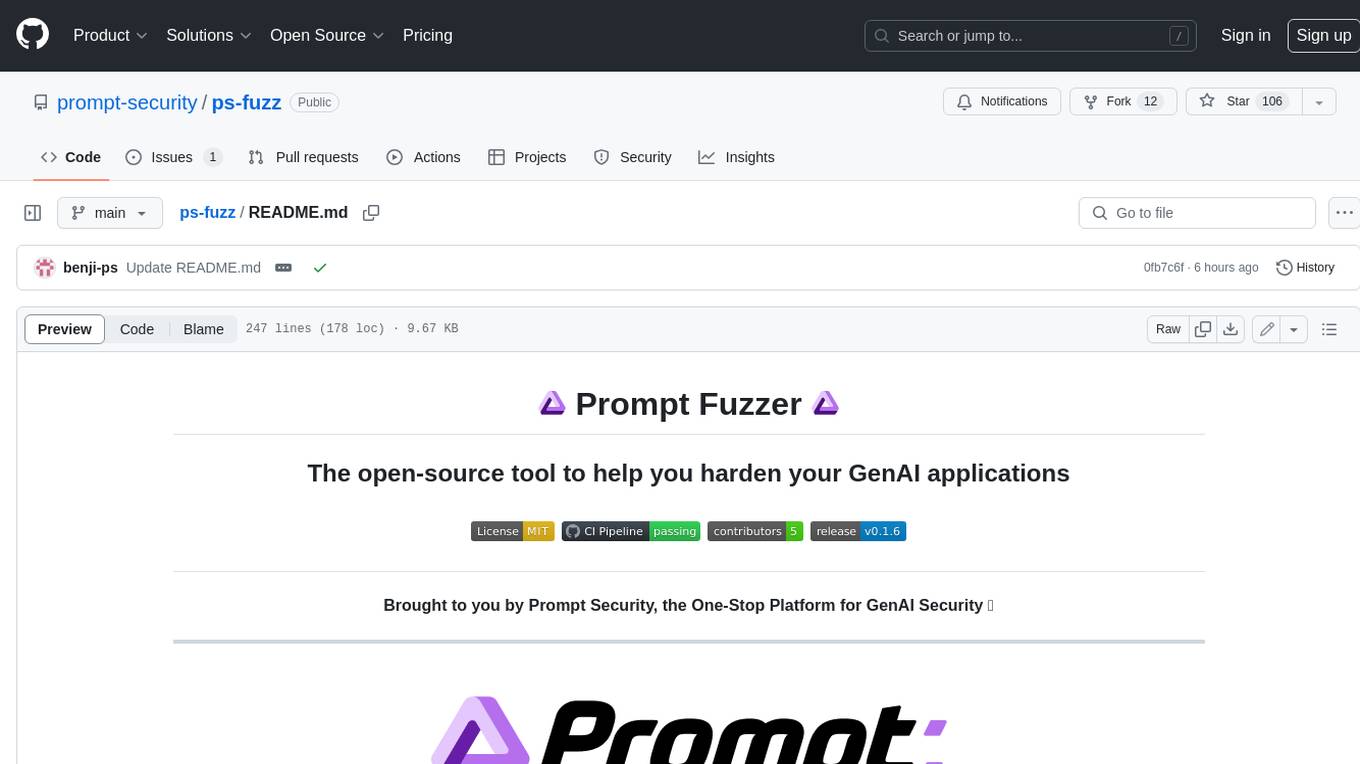
ps-fuzz
The Prompt Fuzzer is an open-source tool that helps you assess the security of your GenAI application's system prompt against various dynamic LLM-based attacks. It provides a security evaluation based on the outcome of these attack simulations, enabling you to strengthen your system prompt as needed. The Prompt Fuzzer dynamically tailors its tests to your application's unique configuration and domain. The Fuzzer also includes a Playground chat interface, giving you the chance to iteratively improve your system prompt, hardening it against a wide spectrum of generative AI attacks.
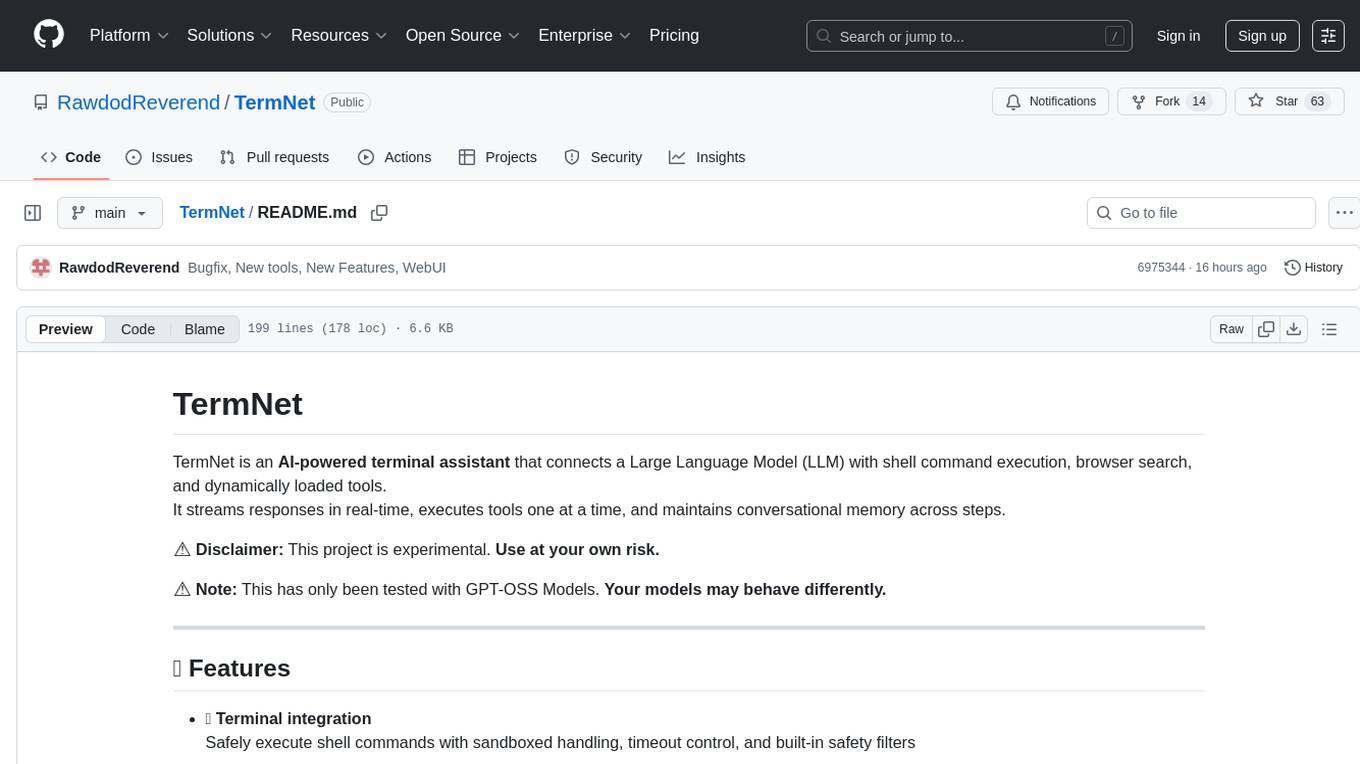
TermNet
TermNet is an AI-powered terminal assistant that connects a Large Language Model (LLM) with shell command execution, browser search, and dynamically loaded tools. It streams responses in real-time, executes tools one at a time, and maintains conversational memory across steps. The project features terminal integration for safe shell command execution, dynamic tool loading without code changes, browser automation powered by Playwright, WebSocket architecture for real-time communication, a memory system to track planning and actions, streaming LLM output integration, a safety layer to block dangerous commands, dual interface options, a notification system, and scratchpad memory for persistent note-taking. The architecture includes a multi-server setup with servers for WebSocket, browser automation, notifications, and web UI. The project structure consists of core backend files, various tools like web browsing and notification management, and servers for browser automation and notifications. Installation requires Python 3.9+, Ollama, and Chromium, with setup steps provided in the README. The tool can be used via the launcher for managing components or directly by starting individual servers. Additional tools can be added by registering them in `toolregistry.json` and implementing them in Python modules. Safety notes highlight the blocking of dangerous commands, allowed risky commands with warnings, and the importance of monitoring tool execution and setting appropriate timeouts.
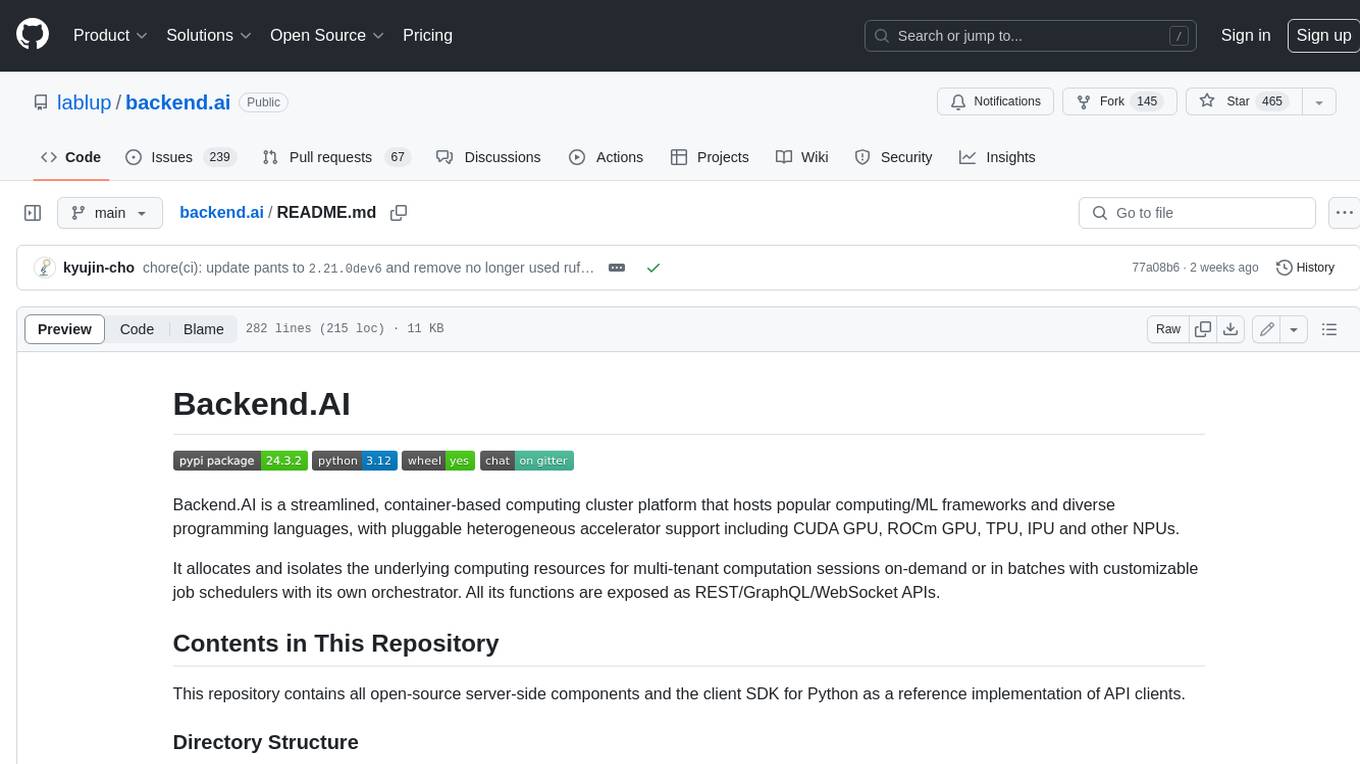
backend.ai
Backend.AI is a streamlined, container-based computing cluster platform that hosts popular computing/ML frameworks and diverse programming languages, with pluggable heterogeneous accelerator support including CUDA GPU, ROCm GPU, TPU, IPU and other NPUs. It allocates and isolates the underlying computing resources for multi-tenant computation sessions on-demand or in batches with customizable job schedulers with its own orchestrator. All its functions are exposed as REST/GraphQL/WebSocket APIs.

rlama
RLAMA is a powerful AI-driven question-answering tool that seamlessly integrates with local Ollama models. It enables users to create, manage, and interact with Retrieval-Augmented Generation (RAG) systems tailored to their documentation needs. RLAMA follows a clean architecture pattern with clear separation of concerns, focusing on lightweight and portable RAG capabilities with minimal dependencies. The tool processes documents, generates embeddings, stores RAG systems locally, and provides contextually-informed responses to user queries. Supported document formats include text, code, and various document types, with troubleshooting steps available for common issues like Ollama accessibility, text extraction problems, and relevance of answers.
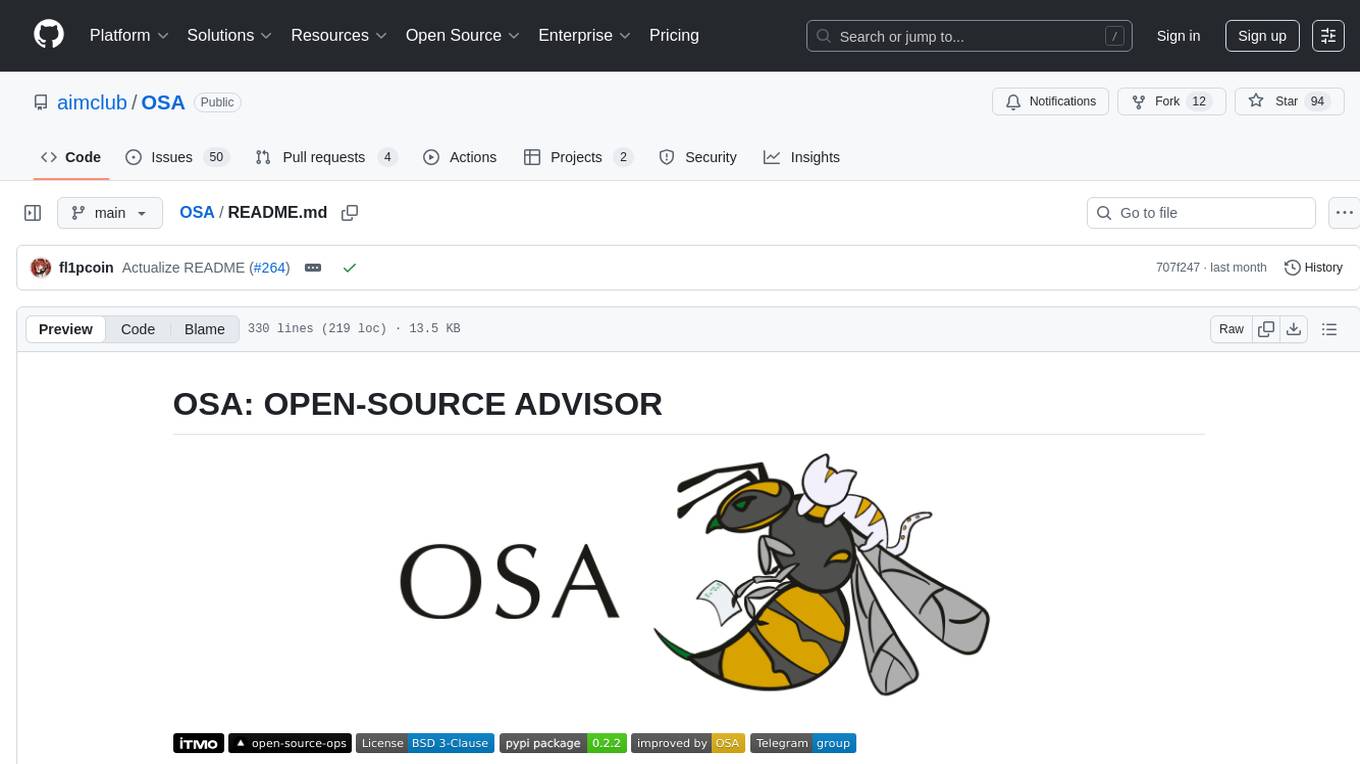
OSA
OSA (Open-Source-Advisor) is a tool designed to improve the quality of scientific open source projects by automating the generation of README files, documentation, CI/CD scripts, and providing advice and recommendations for repositories. It supports various LLMs accessible via API, local servers, or osa_bot hosted on ITMO servers. OSA is currently under development with features like README file generation, documentation generation, automatic implementation of changes, LLM integration, and GitHub Action Workflow generation. It requires Python 3.10 or higher and tokens for GitHub/GitLab/Gitverse and LLM API key. Users can install OSA using PyPi or build from source, and run it using CLI commands or Docker containers.
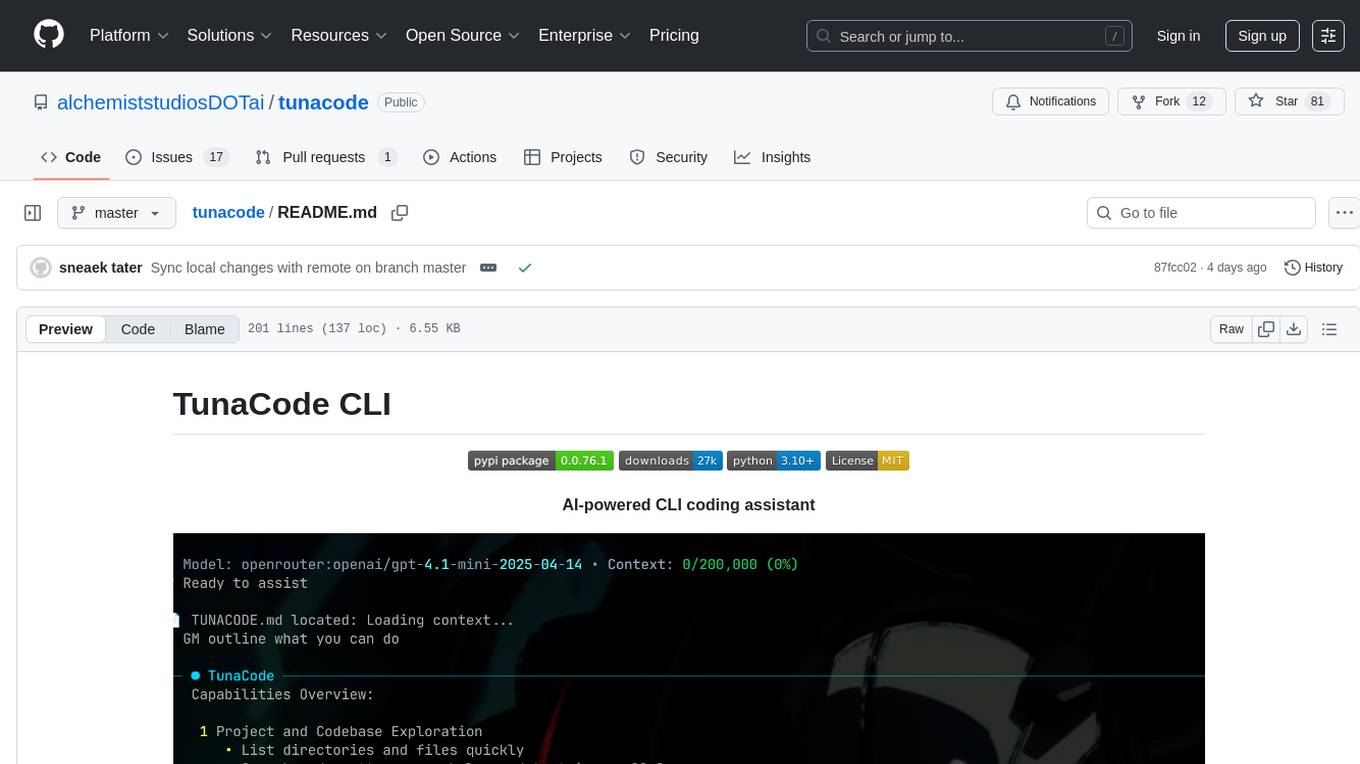
tunacode
TunaCode CLI is an AI-powered coding assistant that provides a command-line interface for developers to enhance their coding experience. It offers features like model selection, parallel execution for faster file operations, and various commands for code management. The tool aims to improve coding efficiency and provide a seamless coding environment for developers.
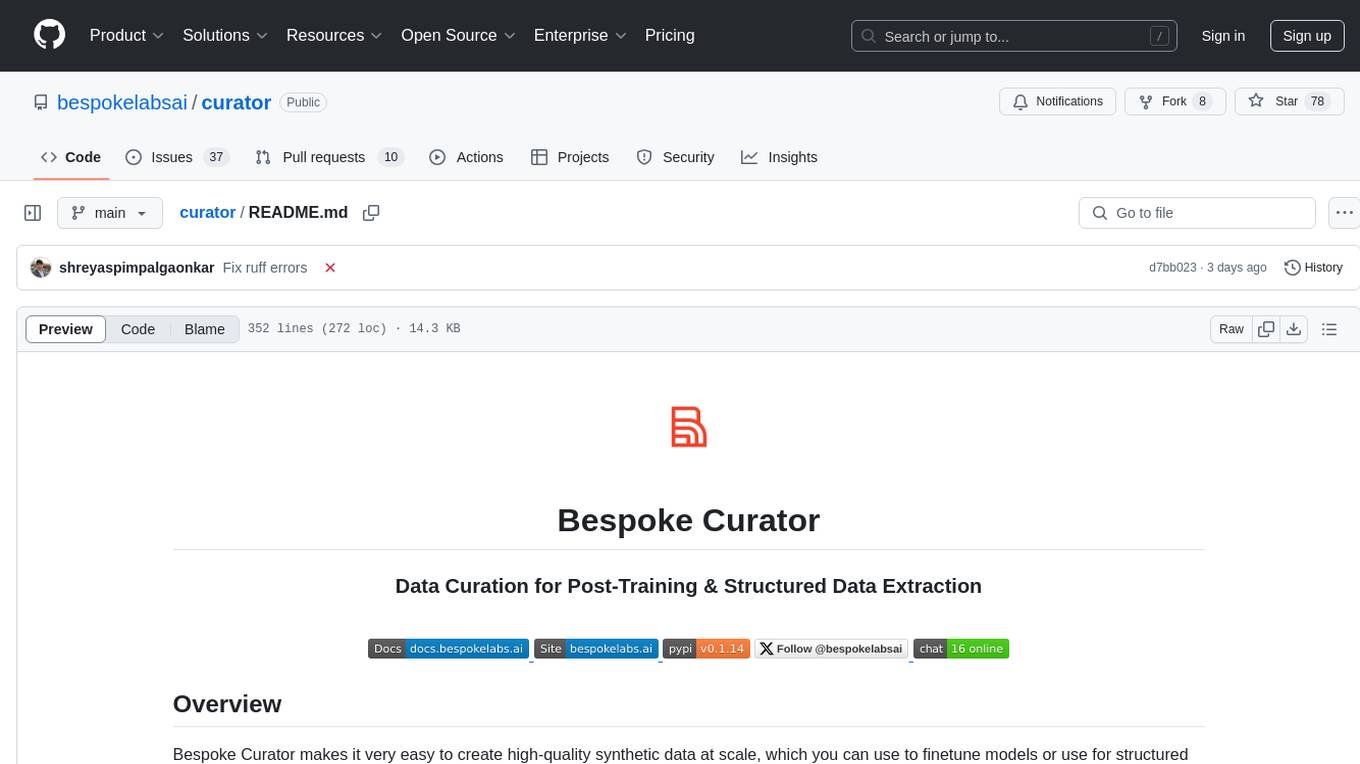
curator
Bespoke Curator is an open-source tool for data curation and structured data extraction. It provides a Python library for generating synthetic data at scale, with features like programmability, performance optimization, caching, and integration with HuggingFace Datasets. The tool includes a Curator Viewer for dataset visualization and offers a rich set of functionalities for creating and refining data generation strategies.
For similar tasks

LLMTSCS
LLMLight is a novel framework that employs Large Language Models (LLMs) as decision-making agents for Traffic Signal Control (TSC). The framework leverages the advanced generalization capabilities of LLMs to engage in a reasoning and decision-making process akin to human intuition for effective traffic control. LLMLight has been demonstrated to be remarkably effective, generalizable, and interpretable against various transportation-based and RL-based baselines on nine real-world and synthetic datasets.
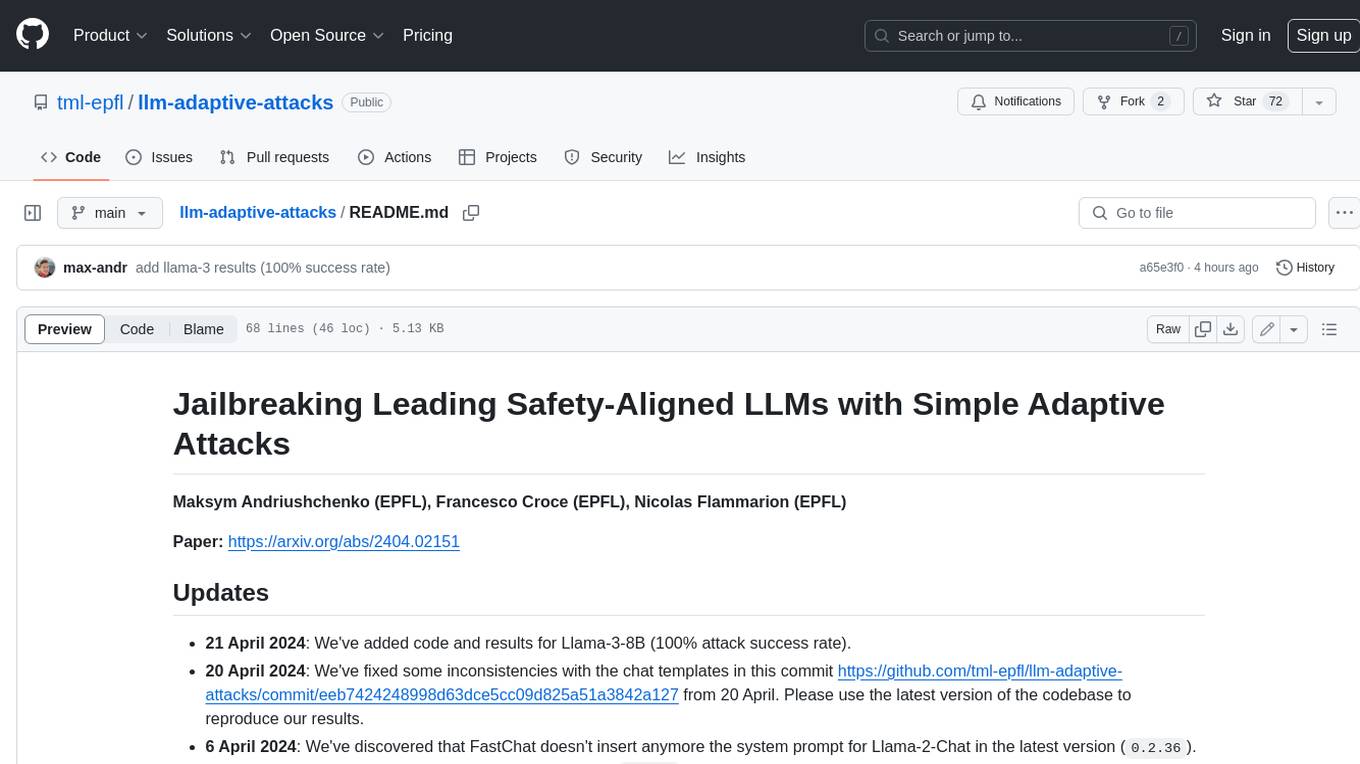
llm-adaptive-attacks
This repository contains code and results for jailbreaking leading safety-aligned LLMs with simple adaptive attacks. We show that even the most recent safety-aligned LLMs are not robust to simple adaptive jailbreaking attacks. We demonstrate how to successfully leverage access to logprobs for jailbreaking: we initially design an adversarial prompt template (sometimes adapted to the target LLM), and then we apply random search on a suffix to maximize the target logprob (e.g., of the token ``Sure''), potentially with multiple restarts. In this way, we achieve nearly 100% attack success rate---according to GPT-4 as a judge---on GPT-3.5/4, Llama-2-Chat-7B/13B/70B, Gemma-7B, and R2D2 from HarmBench that was adversarially trained against the GCG attack. We also show how to jailbreak all Claude models---that do not expose logprobs---via either a transfer or prefilling attack with 100% success rate. In addition, we show how to use random search on a restricted set of tokens for finding trojan strings in poisoned models---a task that shares many similarities with jailbreaking---which is the algorithm that brought us the first place in the SaTML'24 Trojan Detection Competition. The common theme behind these attacks is that adaptivity is crucial: different models are vulnerable to different prompting templates (e.g., R2D2 is very sensitive to in-context learning prompts), some models have unique vulnerabilities based on their APIs (e.g., prefilling for Claude), and in some settings it is crucial to restrict the token search space based on prior knowledge (e.g., for trojan detection).
For similar jobs

weave
Weave is a toolkit for developing Generative AI applications, built by Weights & Biases. With Weave, you can log and debug language model inputs, outputs, and traces; build rigorous, apples-to-apples evaluations for language model use cases; and organize all the information generated across the LLM workflow, from experimentation to evaluations to production. Weave aims to bring rigor, best-practices, and composability to the inherently experimental process of developing Generative AI software, without introducing cognitive overhead.

agentcloud
AgentCloud is an open-source platform that enables companies to build and deploy private LLM chat apps, empowering teams to securely interact with their data. It comprises three main components: Agent Backend, Webapp, and Vector Proxy. To run this project locally, clone the repository, install Docker, and start the services. The project is licensed under the GNU Affero General Public License, version 3 only. Contributions and feedback are welcome from the community.

oss-fuzz-gen
This framework generates fuzz targets for real-world `C`/`C++` projects with various Large Language Models (LLM) and benchmarks them via the `OSS-Fuzz` platform. It manages to successfully leverage LLMs to generate valid fuzz targets (which generate non-zero coverage increase) for 160 C/C++ projects. The maximum line coverage increase is 29% from the existing human-written targets.

LLMStack
LLMStack is a no-code platform for building generative AI agents, workflows, and chatbots. It allows users to connect their own data, internal tools, and GPT-powered models without any coding experience. LLMStack can be deployed to the cloud or on-premise and can be accessed via HTTP API or triggered from Slack or Discord.

VisionCraft
The VisionCraft API is a free API for using over 100 different AI models. From images to sound.

kaito
Kaito is an operator that automates the AI/ML inference model deployment in a Kubernetes cluster. It manages large model files using container images, avoids tuning deployment parameters to fit GPU hardware by providing preset configurations, auto-provisions GPU nodes based on model requirements, and hosts large model images in the public Microsoft Container Registry (MCR) if the license allows. Using Kaito, the workflow of onboarding large AI inference models in Kubernetes is largely simplified.

PyRIT
PyRIT is an open access automation framework designed to empower security professionals and ML engineers to red team foundation models and their applications. It automates AI Red Teaming tasks to allow operators to focus on more complicated and time-consuming tasks and can also identify security harms such as misuse (e.g., malware generation, jailbreaking), and privacy harms (e.g., identity theft). The goal is to allow researchers to have a baseline of how well their model and entire inference pipeline is doing against different harm categories and to be able to compare that baseline to future iterations of their model. This allows them to have empirical data on how well their model is doing today, and detect any degradation of performance based on future improvements.

Azure-Analytics-and-AI-Engagement
The Azure-Analytics-and-AI-Engagement repository provides packaged Industry Scenario DREAM Demos with ARM templates (Containing a demo web application, Power BI reports, Synapse resources, AML Notebooks etc.) that can be deployed in a customer’s subscription using the CAPE tool within a matter of few hours. Partners can also deploy DREAM Demos in their own subscriptions using DPoC.





